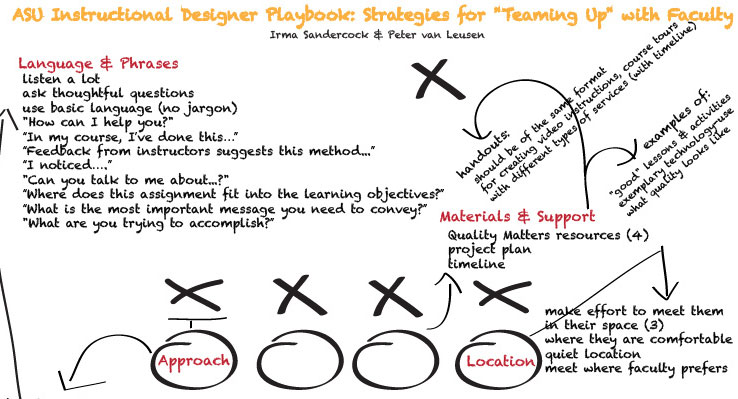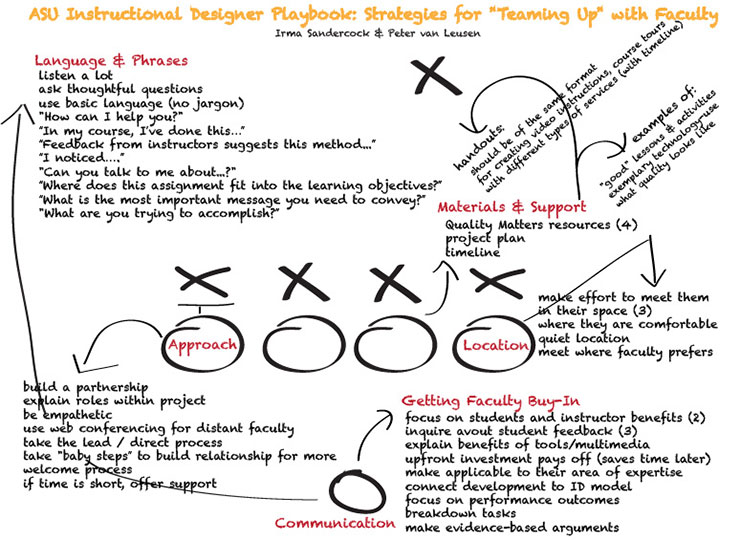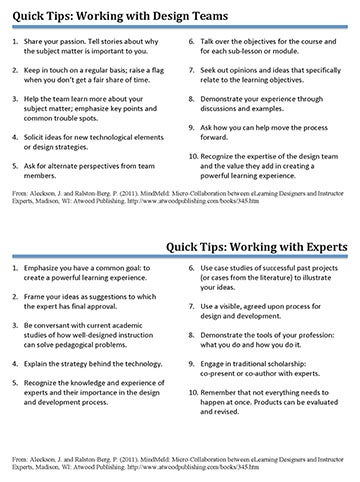
The ASU Instructional Designer: Building Effective Relationships
This post further breaks down some of the activities of Instructional Designers mentioned in the previous TeachOnline post, Introducing the ASU Instructional Designer, and discusses the importance of the relationship between the faculty and instructional designer.

One of the most daunting challenges for teaching online at research-focused institutions of higher education might simply lay within the time constraints of the (often tenure-track) instructors. Due to the many demands and responsibilities – where priorities are generally placed on conducting research, publishing articles, serving on committees, or advising students – there are limited opportunities for the time-consuming tasks of developing online courses or exploring new technologies and their potential pedagogical implications (Kagima & Hausafus, 2001; Nworie, 2009; Tessmer, 1988).
To help their faculty with the many challenges of online teaching, some universities provide assistance in form of Instructional Designers (IDs) and Technologists. To support faculty, IDs and Technologist need to, among many other tasks, develop a thorough understanding of the course, the instructional methods preferred by the instructor, and students’ learning experiences – all in limited time! Research on the practices of IDs in higher education suggests that effective and efficient communication and building trust-based relationships are of the utmost importance when collaborating with faculty (Bratton, 1983; Tessmer; van Leusen & Millard, 2013).
Building Relationships at ASU
Recently during a meeting between ASU Instructional Designers and Technologists, we brainstormed on various strategies for “Teaming Up” with our faculty. Since it was the week before Superbowl, we added a football theme and asked the about 40 attendees, “What’s in your playbook for working with faculty?” Responses of this 5-minute activity were summarized in the main graphic of this blog post.
Tips For Working With Designers / Faculty

Our discussion as well as the research previously mentioned suggest that effective communication skills and trust-based relationships between designers/technologists and faculty are important attributes for establishing, maintaining, and improving successful online programs. In addition to these resources, Aleckson and Ralston-Berg (2011), authors of Mindmeld: Micro-Collaboration between eLearning Designers and Instructor Experts, provide concrete tips for working with designers (ie., Instructional Designers, Technologists) and instructor experts (ie., faculty).
Do you have a strategy for building effective relationships with Instructional Designers, Technologists, and faculty? Please share them as a comment below.
References
- Aleckson, J., & Ralston-Berg, P. (2011). MindMeld: Micro-Collaboration between eLearning designers and instructor experts. Madison, WI: Atwood Publishing.
- Bratton, B. (1983). The instructional design specialist-subject matter expert relationship. Educational Technology, 23(6), 13-16.
- Kagima, L. K. & Hausafus, C. O. (2001). Faculty: The central element in instructional technology integration. Journal of Family and Consumer Sciences, 93(4), 33-36.
- Nworie, J. (2009). Managing the growing complexity of administration of academic technology in higher education. AACE Journal, 17 (1), 23-44.
- Tessmer, M. (1988). Subject specialist consultation in instructional design: Higher education. Journal of Instructional Development, 11(2), 29-35.
- van Leusen, P. & Millard, M. (2013). Interpersonal Consulting Skills: Developing effective relationships with online faculty – A multiple case study. In T. Bastiaens & G. Marks (Eds.), Proceedings of World Conference on E-Learning in Corporate, Government, Healthcare, and Higher Education 2013 (pp. 2150-2158). Chesapeake, VA: AACE.
Co-written with Irma Sandercock.
Leave a Comment
Your email address will not be published. Required fields are marked *